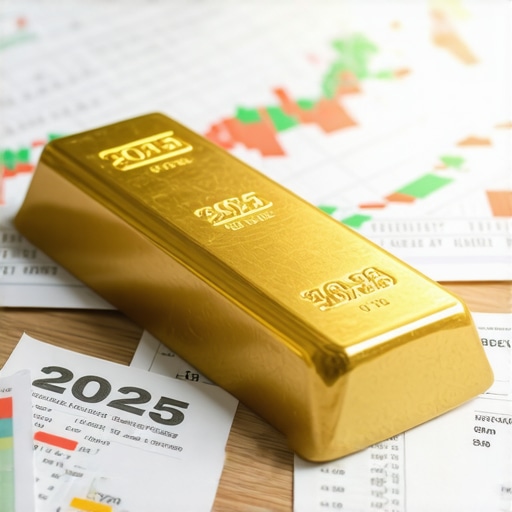Unlocking the Future of Diversified Investment Portfolios: The Strategic Role of Gold ETFs & Mutual Funds in 2025
In the rapidly evolving landscape of global finance, sophisticated investors recognize that diversification remains the cornerstone of resilient wealth accumulation. As we approach 2025, understanding the nuanced interplay between Gold Exchange-Traded Funds (ETFs) and mutual funds becomes imperative for constructing portfolios that withstand economic turbulence and capitalize on emerging market trends.
Why Gold Continues to Be a Cornerstone of Diversification in 2025
Gold’s unique status as a hedge against inflation and economic uncertainty persists, especially amidst geopolitical tensions and fluctuating fiat currencies. According to market analysis, gold demand is poised to remain robust in 2025, driven by central bank purchases and shifting investor sentiment. This resilience underscores the strategic importance of integrating gold-based instruments within diversified asset classes.
Strategic Insights into Gold ETFs and Mutual Funds: Advanced Perspectives
How can investors optimize risk-adjusted returns through thematic gold mutual funds in 2025?
Expert investors leverage thematic mutual funds that focus on gold mining stocks, physical gold, and gold futures to align with macroeconomic trends. These funds offer diversification within the precious metals sector, mitigating sector-specific risks while tapping into growth trajectories driven by technological innovations and supply-demand dynamics.
Additionally, gold ETFs provide liquidity and transparency, enabling tactical adjustments based on market signals. To maximize gains, seasoned investors analyze trading techniques that exploit technical patterns and macroeconomic indicators, ensuring nimble portfolio management.
Integrating Gold Investment Vehicles into a Broader Portfolio
Beyond ETFs and mutual funds, consider physical gold investments such as coins and bars, especially for wealth preservation. When executed with reputable dealers, these assets serve as tangible insurance against systemic risks. Complementing physical holdings with derivatives and futures can further enhance strategic positioning against market volatility.
Expert-Driven Considerations for 2025: Supply, Demand, and Price Drivers
Emerging trends in supply-demand fundamentals, including central bank policies and jewelry industry demand, are pivotal in shaping price trajectories. As analysts highlight, understanding these drivers enhances predictive accuracy, enabling investors to preempt market swings effectively.
What are the critical risks in gold ETF and mutual fund investments in 2025, and how can they be mitigated?
Market risks stem from geopolitical shifts, regulatory changes, and macroeconomic shocks. Diversification within the precious metals sector, combined with adaptive trading strategies, can mitigate these risks. Continuous market monitoring and consulting authoritative sources, such as price forecasts, are essential for dynamic risk management.
For investors seeking to refine their approach, exploring comprehensive research on top ETFs and mutual funds for 2025 offers valuable insights into optimized asset selection. Engage with industry experts and contribute your insights to foster a community of informed, strategic investors.
Leveraging Advanced Analytical Tools for Gold Investment Decisions in 2025
In the quest for optimal diversification, investors are increasingly turning to sophisticated analytical frameworks that integrate macroeconomic indicators, supply-demand fundamentals, and technical analysis. Tools such as strategic trading techniques enable traders to identify entry and exit points with precision, especially in volatile markets. Combining these with real-time economic data enhances the ability to anticipate price movements and adjust portfolios proactively.
How Can Investors Challenge Conventional Wisdom on Gold’s Role in 2025 Portfolios?
While gold is traditionally viewed as a safe haven, emerging research suggests that in 2025, its role could expand beyond hedging to include active participation in growth strategies. For example, integrating gold mining stocks with physical gold and ETFs can diversify exposure to different facets of the sector, providing both growth potential and stability. Critical analysis from industry experts indicates that a nuanced approach—balancing physical assets with derivatives—can unlock higher returns while managing risks effectively.
What Are the Emerging Technological Trends Influencing Gold Market Dynamics?
Blockchain technology and digital gold representations are revolutionizing investment landscapes. Digital gold platforms and tokenized assets are gaining traction, offering increased liquidity and accessibility for investors worldwide. According to market analysts, these innovations could reshape how investors approach physical gold and ETFs, creating new opportunities for portfolio enhancement and risk mitigation.
Furthermore, advanced data analytics and machine learning models are now capable of predicting market shifts with increased accuracy, allowing investors to refine their strategies continually. Exploring these technological frontiers can provide a competitive edge—especially as supply-demand dynamics evolve rapidly in 2025.
Are We Overestimating the Protective Power of Gold During Economic Turmoil?
This question challenges the traditional assumption that gold always acts as a reliable hedge. While historical data supports gold’s role in safeguarding wealth, recent market anomalies and geopolitical shifts demand a more nuanced perspective. Combining gold assets with other non-correlated investments—such as real estate or innovative financial instruments—can create a more resilient portfolio. Continuous research from sources like industry reports emphasizes the importance of dynamic risk management in uncertain times.
Investors should consider engaging with comprehensive analysis tools and expert insights to navigate this complex environment effectively. Sharing your experiences or questions in the comments can foster a community of informed gold investors.
Innovative Portfolio Optimization: Leveraging Quantitative Models to Maximize Gold Asset Performance in 2025
As the gold investment landscape evolves, sophisticated investors are increasingly turning to quantitative analysis and algorithmic trading models to gain an edge. Advanced statistical techniques, such as Monte Carlo simulations and machine learning algorithms, enable precise risk-return profiling of gold ETFs and mutual funds under various macroeconomic scenarios. According to a study by The Journal of Financial Data Science, integrating these models into portfolio management can significantly enhance decision-making accuracy, especially amidst volatile market conditions prevalent in 2025.
Implementing these strategies involves dissecting historical price patterns, supply-demand fundamentals, and geopolitical risk indicators to forecast potential asset trajectories. Investors who harness real-time analytics and adaptive algorithms can dynamically rebalance holdings, optimizing for risk-adjusted returns. For example, employing Bayesian networks to update probability estimates as new data emerges can refine entry and exit points, reducing exposure to unforeseen downturns.
Moreover, integrating alternative data sources, such as blockchain transaction flows and sentiment analysis from financial news, can provide nuanced insights not captured by traditional metrics. This multi-layered approach fosters a resilient and agile investment posture, essential for navigating the uncertainties of 2025’s economic environment.
Interested in how cutting-edge analytics can transform your gold investment strategy? Consulting specialized quantitative finance tools and collaborating with data scientists can unlock untapped potential within your portfolio. Dive deeper into these methodologies and future-proof your assets today.
The Future of Digital Gold: Blockchain and Tokenization Impact on ETF & Mutual Fund Efficiency
The advent of blockchain technology and digital asset tokenization is revolutionizing the gold investment ecosystem. By converting physical gold into blockchain-backed tokens, investors gain unprecedented liquidity, fractional ownership, and transparency. According to a report by Morgan Stanley, tokenized gold can reduce transaction costs and settlement times, thus enabling more efficient portfolio rebalancing and risk management in 2025.
Tokenization also democratizes access, allowing smaller investors to participate in gold markets previously limited to institutional players. This innovation opens avenues for creating diversified gold-linked ETFs that are more responsive to market dynamics. Additionally, integrating smart contracts can automate compliance, dividend payouts, and rebalancing rules, reducing operational risks and costs.
However, these emerging technologies demand rigorous due diligence. Investors must scrutinize the security protocols, regulatory acceptance, and custodial arrangements associated with digital gold products. Engaging with industry leaders and blockchain experts can facilitate a safer transition into this digital frontier, ensuring your portfolio benefits from technological advancements without exposing it to undue risks.
Deep Dive: How Do Macro-Economic Shifts Influence Gold ETF & Mutual Fund Performance in 2025?
Understanding the macroeconomic landscape is crucial for strategic gold investments. Factors such as interest rate policies, inflation trajectories, currency fluctuations, and geopolitical tensions significantly influence gold’s performance. For instance, the Federal Reserve’s monetary tightening or easing directly impacts gold prices through rate differentials and dollar strength, as highlighted in the IMF’s World Economic Outlook.
In 2025, the interplay between inflation expectations and real yields will be particularly telling. When real interest rates decline, gold’s appeal as a non-yielding asset intensifies, attracting investors seeking refuge from rising prices. Conversely, periods of rising real yields can diminish gold’s attractiveness, prompting tactical rebalancing.
Investors should also monitor geopolitical developments—such as trade tensions, conflicts, or policy shifts—that can trigger safe-haven flows into gold. Utilizing economic indicators like the Purchasing Managers’ Index (PMI), inflation reports, and currency indices enables dynamic portfolio adjustment aligned with macro trends. Engaging with macroeconomic research and expert forecasts ensures your gold assets are positioned optimally amidst these complex influences.
How can sophisticated investors utilize scenario analysis to hedge against macroeconomic uncertainties in gold investments?
Scenario analysis involves constructing plausible future states of the world based on variables like interest rates, inflation, and geopolitical risks. By simulating portfolio performance across these scenarios, investors can identify vulnerabilities and develop contingency plans. For example, stress-testing gold ETFs against a hypothetical sudden dollar decline or inflation surge reveals potential drawdowns and guides strategic hedging through options or futures. According to the CFA Institute, integrating scenario analysis into routine risk management enhances resilience, especially in unpredictable environments like 2025.
To implement this, leverage advanced financial modeling software that incorporates macroeconomic variables and probabilistic outcomes. Regularly updating these models with real-time data ensures that your risk mitigation strategies remain relevant and effective. Engaging with financial advisors experienced in scenario planning can further refine your approach, making your gold investments more robust against macroeconomic shocks.
Harnessing Quantitative Analysis to Elevate Gold Investment Strategies in 2025
As the landscape of precious metals investing becomes increasingly sophisticated, integrating quantitative models such as Monte Carlo simulations and machine learning algorithms can provide a decisive edge. These tools facilitate intricate risk-return assessments of gold ETFs and mutual funds, allowing investors to anticipate potential market fluctuations with heightened precision. According to The Journal of Financial Data Science, embedding these analytical frameworks into portfolio management processes enhances decision-making efficacy amidst volatile macroeconomic conditions.
By dissecting historical price data, supply-demand fundamentals, and geopolitical indicators, investors can develop dynamic rebalancing strategies that adapt to evolving market signals. Employing Bayesian networks for probabilistic updates, for example, refines entry and exit points, thereby reducing exposure to unforeseen downturns. Incorporating alternative data sources, such as blockchain transaction analytics and sentiment analysis, further enriches the predictive landscape, fostering a resilient and forward-looking investment posture for 2025.
What Are the Key Technological Innovations Reshaping Gold Market Dynamics?
Emerging technologies such as blockchain and tokenization are revolutionizing gold investment paradigms. Digital gold platforms enable fractional ownership and instantaneous settlement, significantly reducing transaction costs and operational risks. As Morgan Stanley highlights, tokenized assets empower investors with enhanced liquidity, transparency, and accessibility. Smart contracts automate compliance and dividend distributions, streamlining portfolio management and rebalancing processes.

To capitalize on these innovations, investors should conduct rigorous due diligence on security protocols, regulatory status, and custodial arrangements associated with digital gold. Partnering with industry leaders in blockchain technology ensures a safer transition into digital assets, unlocking new opportunities for diversification and risk mitigation within gold investment portfolios.
How Do Macro-Economic Variables Precisely Influence Gold ETF & Mutual Fund Performance?
The interplay of interest rate policies, inflation expectations, currency fluctuations, and geopolitical tensions critically shapes gold’s performance trajectory. For instance, the IMF’s World Economic Outlook emphasizes that declining real interest rates tend to bolster gold’s appeal as a non-yielding asset, especially amid rising inflationary pressures. Conversely, rising real yields often diminish its attractiveness, prompting tactical portfolio adjustments.
Investors should leverage macroeconomic indicators such as PMI, CPI reports, and currency indices to inform dynamic rebalancing strategies. Engaging with expert forecasts and real-time economic data enhances the ability to navigate complex macro environments effectively, reducing vulnerability to systemic shocks.
In what ways can scenario analysis improve risk mitigation in gold investments amidst macroeconomic uncertainties?
Constructing plausible future states based on interest rate movements, inflation trends, and geopolitical risks enables investors to stress-test portfolios against adverse scenarios. For example, simulating a sudden dollar decline or inflation spike reveals potential vulnerabilities, guiding hedging strategies using options and futures. As outlined by the CFA Institute, integrating scenario analysis into risk management enhances resilience, particularly in unpredictable environments like 2025. Regularly updating these models with real-time data ensures adaptive and robust risk mitigation, fostering more resilient gold portfolios.
Expert Insights & Advanced Considerations
1. Diversification Beyond Traditional Assets
Leading analysts emphasize integrating gold ETFs with emerging digital assets like tokenized gold to enhance liquidity and access. This approach not only broadens diversification but also mitigates systemic risks in volatile markets.
2. Technological Innovations Driving Market Dynamics
Blockchain and smart contract technologies are revolutionizing gold trading, reducing transaction costs and increasing transparency. Investors who leverage these tools gain a strategic edge in portfolio management for 2025.
3. Macro-Economic Scenario Planning
Expert strategy involves rigorous scenario analysis based on interest rate fluctuations and geopolitical tensions. This proactive approach allows investors to adapt swiftly, safeguarding wealth against macroeconomic shocks.
4. Quantitative and Data-Driven Strategies
Utilizing advanced models like Monte Carlo simulations and machine learning algorithms enables precise risk assessment and optimized asset allocation, crucial for navigating complex market environments in 2025.
5. Integrating Physical and Financial Gold
Combining tangible assets such as gold coins and bars with ETFs and derivatives offers a resilient, multi-layered defense against inflation and market downturns, aligning with expert wealth preservation principles.
Curated Expert Resources
- Buy Gold Now – Market Analysis & Price Forecasts: Offers comprehensive insights into supply-demand fundamentals and future price drivers essential for expert-level decision-making.
- Journal of Financial Data Science: Provides cutting-edge research on quantitative models and machine learning applications in asset management, vital for sophisticated investors.
- Morgan Stanley Reports on Digital Gold & Blockchain: Delivers authoritative analyses of technological impacts on gold markets, guiding strategic adoption of digital assets.
- CFA Institute Scenario Analysis Guides: Equips investors with frameworks to simulate macroeconomic shocks, enhancing resilience in portfolio planning.
- IMF World Economic Outlook: Critical macroeconomic data and forecasts that inform strategic positioning of gold assets in response to global trends.
Final Expert Perspective
In the evolving landscape of gold investment for 2025, integrating traditional assets with innovative technological solutions and advanced analytical models is paramount. A nuanced understanding of macroeconomic dynamics, combined with strategic diversification across physical and financial gold, empowers investors to optimize risk-adjusted returns. For those committed to mastery, engaging with authoritative resources and applying sophisticated scenario planning will be the differentiators of success. I invite you to deepen your expertise—share your insights or explore tailored strategies to elevate your gold portfolio in this dynamic era.









